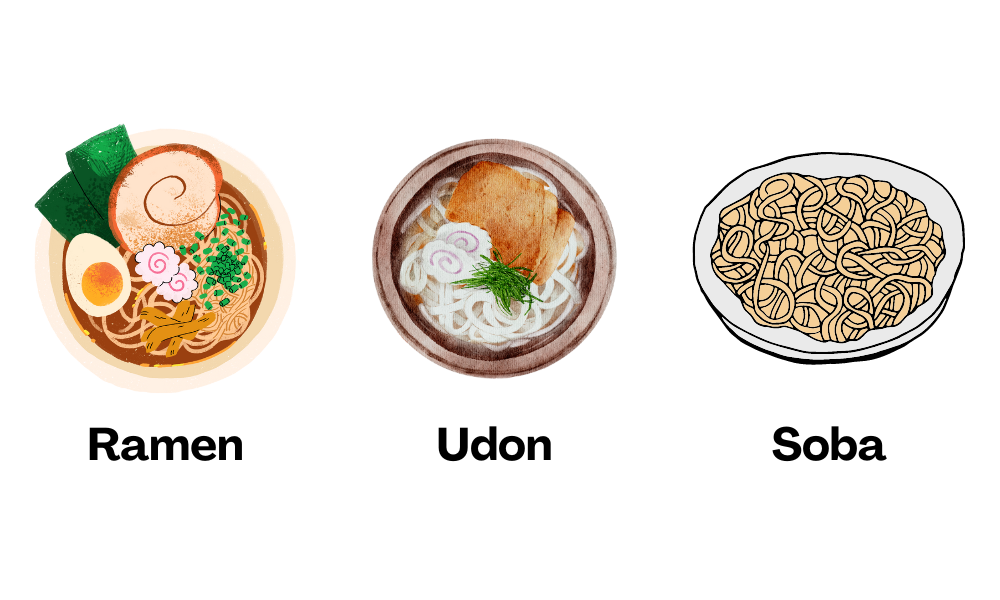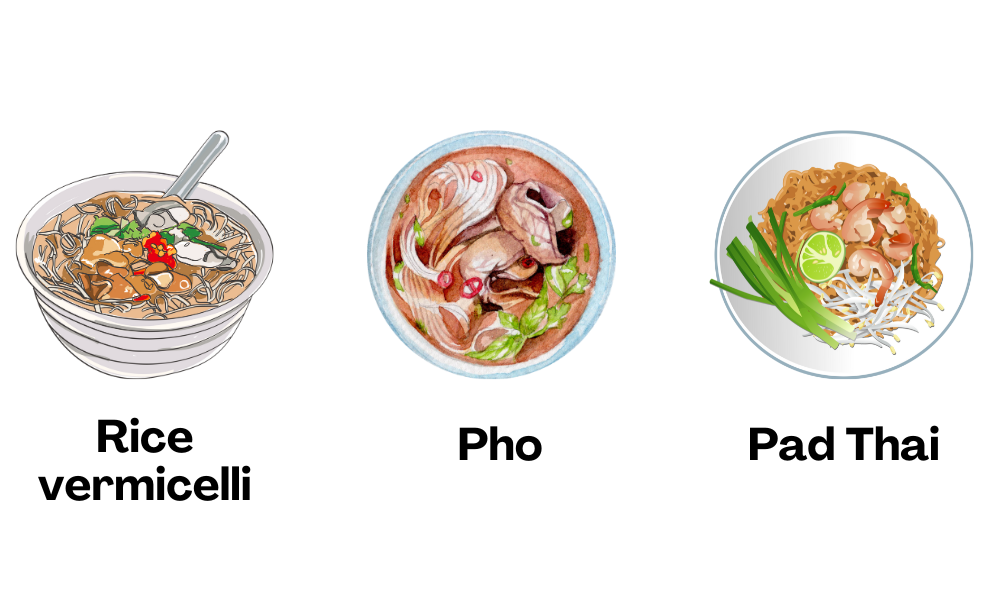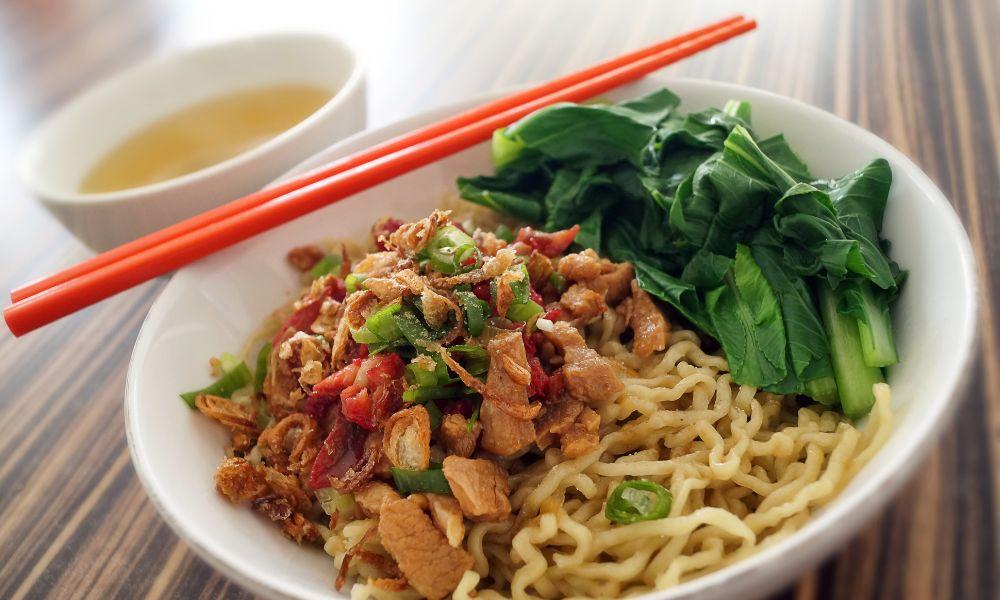Noodles, a staple in many cuisines around the world, are more than just a comfort food. With a vast array of noodle types available, it’s no wonder that many people are on the lookout for the healthiest option.
This article aims to unravel the mystery and reveal the healthiest type of noodle for your taste buds and well-being.

The World of Noodles: Different Types and Ingredients
01 Wheat-based noodles

Wheat-based noodles are common in many Asian and Western cuisines. They are made from wheat flour, which provides a firm texture and a slightly nutty flavor. Here are some popular wheat-based noodles:
- Ramen – A Japanese noodle variety, typically served in a rich broth with various toppings like sliced pork, green onions, and seaweed. Ramen noodles are made with wheat flour, water, and kansui, an alkaline solution that gives the noodles their characteristic chewiness.
- Udon – Another Japanese noodle, udon is thicker and chewier than ramen. It’s commonly served in a mild, soy-based broth with toppings such as tempura, fried tofu, and vegetables.
- Soba – Made from a combination of wheat and buckwheat flours, soba noodles have a distinct earthy flavor. They can be served either hot in a broth or cold with a dipping sauce.
02 Rice-based noodles

Rice-based noodles are a popular gluten-free alternative to wheat-based noodles. They are made from rice flour and have a delicate, slightly chewy texture. Some common rice-based noodles include:
- Rice vermicelli – These thin, delicate noodles are used in various Asian dishes, such as Vietnamese spring rolls and Singapore-style noodles.
- Pho – A Vietnamese noodle soup, pho features flat rice noodles in a flavorful broth, usually with meat and various herbs.
- Pad Thai – A popular Thai dish, pad Thai combines rice noodles with a tangy tamarind sauce, eggs, tofu, and various vegetables.
03 Alternative flour noodles
For those looking for even healthier options or have dietary restrictions, alternative flour noodles provide a wide range of choices. Some popular alternative flour noodles include:
- Chickpea noodles – Made from chickpea flour, these noodles are high in protein and fiber, making them a great option for those looking for a healthier pasta substitute.
- Lentil noodles – Similar to chickpea noodles, lentil noodles are made from lentil flour and offer a high-protein, high-fiber alternative to traditional wheat-based noodles.
- Quinoa noodles – Quinoa is a complete protein, containing all nine essential amino acids. Quinoa noodles are made from quinoa flour and provide a nutritious and gluten-free option for noodle lovers.
Now that we’ve explored the various types of noodles, let’s delve into the healthiest type of noodle. In the next section, we’ll discuss the nutritional benefits and drawbacks of each type of noodle, and ultimately determine the healthiest choice.
The Nutrition of Noodles: What Makes a Noodle Healthy?

Navigating the world of noodles can be overwhelming, especially when you’re trying to make the healthiest choice. To help make an informed decision, let’s examine the nutritional aspects of noodles and share some personal experiences with each type.
1. Macronutrients
Macronutrients are the main components of our diet and provide energy for our bodies. They include carbohydrates, proteins, and fats. When selecting a healthy noodle, it’s essential to consider the macronutrient composition.
- Carbohydrates – As a runner, I’ve always been a fan of carbohydrates for fueling my workouts. However, I realized that not all carbohydrates are created equal. Whole grain noodles, such as whole wheat or soba, are a better choice due to their higher fiber content and slower digestion rate.
- Proteins – Protein is essential for muscle repair and growth. While most noodles are low in protein, alternative flour noodles, like chickpea and lentil noodles, are a game-changer. As a vegetarian, I’ve found these noodles to be a convenient and delicious way to increase my protein intake.
- Fats – Most noodles are low in fat, but it’s essential to consider the type of fat when preparing a noodle dish. Using healthy fats, such as olive oil or avocado, can improve the overall nutritional value of your meal.
2. Micronutrients
Micronutrients, such as vitamins and minerals, are crucial for overall health and well-being. When comparing noodle types, it’s essential to consider their micronutrient content.
- Vitamins – Some noodles, like whole wheat and quinoa noodles, are fortified with essential vitamins like B-vitamins and vitamin E. Including these noodles in your diet can help support various bodily functions, such as energy production and immune system function.
- Minerals – Minerals like iron, magnesium, and zinc are essential for various bodily processes. Whole grain and alternative flour noodles tend to be higher in these minerals compared to their refined counterparts.
3. Fiber content
Fiber is essential for digestion and maintaining a healthy gut. In my quest for the healthiest noodle, I’ve discovered that whole grain noodles, such as whole wheat and soba, and alternative flour noodles, like chickpea and lentil noodles, have higher fiber content than their refined counterparts.
4. Glycemic index
The glycemic index (GI) measures how quickly a food raises blood sugar levels. As someone with a family history of diabetes, I’m particularly mindful of the GI of my food choices. Lower GI noodles, like whole grain and alternative flour noodles, can help maintain stable blood sugar levels and reduce the risk of diabetes and heart disease.
Comparing the Healthiest Noodle Options
With so many healthy noodle options available, it can be challenging to choose the best one for your needs. In this section, I’ll compare the healthiest noodle options based on my personal experiences and preferences, making it easier for you to make an informed choice.
| Noodle Type | Key Features | Personal Experience |
|---|---|---|
| Whole grain | High in fiber, better blood sugar control | Hearty texture, robust flavor, versatile in various dishes |
| Gluten-free | Suitable for gluten sensitivities or celiac disease | Rice noodles for pho and pad Thai, quinoa noodles as pasta substitute |
| High-protein | Ideal for plant-based diets or those looking to increase protein intake | Chickpea noodles pair well with different sauces, lentil noodles work well with hearty vegetables |
| Low-carb | Suitable for low-carb or ketogenic diets | Shirataki noodles absorb flavors well, zucchini noodles as a light pasta alternative |
Whole grain noodles
Whole grain noodles, such as whole wheat and soba, are an excellent choice for those looking to boost their fiber intake and maintain stable blood sugar levels. I’ve found that whole grain noodles have a heartier texture and a more robust flavor compared to refined noodles. They’re versatile and can be used in various dishes, such as stir-fries and cold noodle salads. For me, whole grain noodles have become a go-to option for a satisfying and wholesome meal.
Gluten-free noodles
Gluten-free noodles, like rice and quinoa noodles, cater to those with gluten sensitivities or celiac disease. As someone who doesn’t have gluten issues, I was initially hesitant to try these noodles. However, I’ve found that rice noodles are perfect for dishes like pho and pad Thai, while quinoa noodles offer a slightly nutty flavor and are a great substitute for traditional pasta. If you’re looking for gluten-free options, these noodles are both delicious and versatile.
High-protein noodles
High-protein noodles, such as chickpea and lentil noodles, have been a revelation for me as a vegetarian. These noodles provide a substantial protein boost, making them perfect for those looking to increase their protein intake or follow plant-based diets. I’ve found that chickpea noodles have a mild flavor that works well with a variety of sauces, while lentil noodles have a slightly earthier taste that pairs well with heartier vegetable dishes. For protein-packed meals, these noodles are an excellent choice.
Low-carb noodles
For those following low-carb or ketogenic diets, low-carb noodles, like shirataki or zucchini noodles, offer a guilt-free alternative. My first experience with shirataki noodles was surprising – they have a slightly rubbery texture but absorb flavors well, making them suitable for dishes like stir-fries or soups. On the other hand, zucchini noodles, or “zoodles,” are a vegetable-based option that I’ve found to be a refreshing and lighter alternative to traditional pasta. While they don’t have the same texture as wheat-based noodles, they’re a delicious and healthy option for those watching their carb intake.
Customizing Your Noodle Experience

Creating a healthy noodle dish is about more than just choosing the right type of noodle. It’s also about customizing your meal with nutritious and flavorful ingredients.
01 Adding vegetables
Incorporating vegetables into your noodle dishes is a fantastic way to boost their nutritional value and add color, texture, and flavor. One of my go-to moves is to add a mix of fresh and cooked vegetables to my noodle dishes. For example, I love combining sautéed mushrooms, bell peppers, and carrots with fresh spinach or kale in a stir-fry or pasta dish. The variety of colors, flavors, and textures creates a vibrant and satisfying meal.
02 Incorporating lean proteins
Adding lean proteins to your noodle dishes can help keep you feeling fuller for longer and support muscle growth and repair. As a vegetarian, I’ve experimented with various plant-based protein sources like tofu, tempeh, and edamame. I’ve found that marinated and pan-fried tofu works wonders in a noodle stir-fry, while tempeh can add a delicious, nutty flavor to pasta dishes. For meat-eaters, grilled chicken, turkey, or fish can also make excellent protein-rich additions.
03 Choosing healthy sauces and condiments
Sauces and condiments can make or break the healthiness of your noodle dish. Instead of using store-bought sauces that can be high in sodium and added sugars, I’ve enjoyed experimenting with making my own healthier alternatives. For example, I’ve made a delicious peanut sauce using natural peanut butter, low-sodium soy sauce, lime juice, and a touch of honey. This homemade sauce elevates my noodle dishes while keeping the sodium and sugar content in check.
04 Portion control and moderation
As a noodle lover, it can be tempting to go overboard with portion sizes. Over the years, I’ve learned the importance of moderation and portion control. I like to use smaller plates or bowls to help control my serving size and ensure I’m not overeating. Also, by filling half my plate with vegetables and dividing the remaining half between noodles and protein, I create a balanced and satisfying meal without overindulging.
Summary
In this article, we explored the healthiest types of noodles and how to customize your noodle experience for a nutritious and satisfying meal. Whole grain, gluten-free, high-protein, and low-carb noodles all offer various health benefits, depending on your dietary preferences and nutritional goals.
To further enhance your noodle dishes, consider adding a mix of fresh and cooked vegetables, incorporating lean proteins, choosing healthy sauces and condiments, and practicing portion control and moderation. By making mindful choices and experimenting with different ingredients, you can enjoy a delicious and wholesome noodle meal that caters to your specific needs and preferences.
FAQs
What are the healthiest types of noodles?
Whole grain, gluten-free, high-protein, and low-carb noodles are among the healthiest options. Your choice will depend on your dietary preferences, nutritional goals, and personal taste.
How can I incorporate more vegetables into my noodle dishes?
You can add a mix of fresh and cooked vegetables, such as sautéed mushrooms, bell peppers, and carrots, along with fresh spinach or kale. This adds color, texture, and flavor to your dish, making it more nutritious and visually appealing.
What are some lean protein options for noodle dishes?
For plant-based diets, tofu, tempeh, and edamame are great protein sources. For meat-eaters, grilled chicken, turkey, or fish can be excellent protein-rich additions to noodle dishes.
How can I make my own healthy sauces for noodle dishes?
Experiment with homemade sauces using natural ingredients, such as natural peanut butter, low-sodium soy sauce, lime juice, and a touch of honey for a healthier peanut sauce. Homemade sauces can help you control sodium and sugar content in your noodle dishes.
How can I practice portion control with noodle dishes?
Use smaller plates or bowls to control serving sizes, and fill half your plate with vegetables, dividing the remaining half between noodles and protein. This approach helps create a balanced and satisfying meal without overindulging.